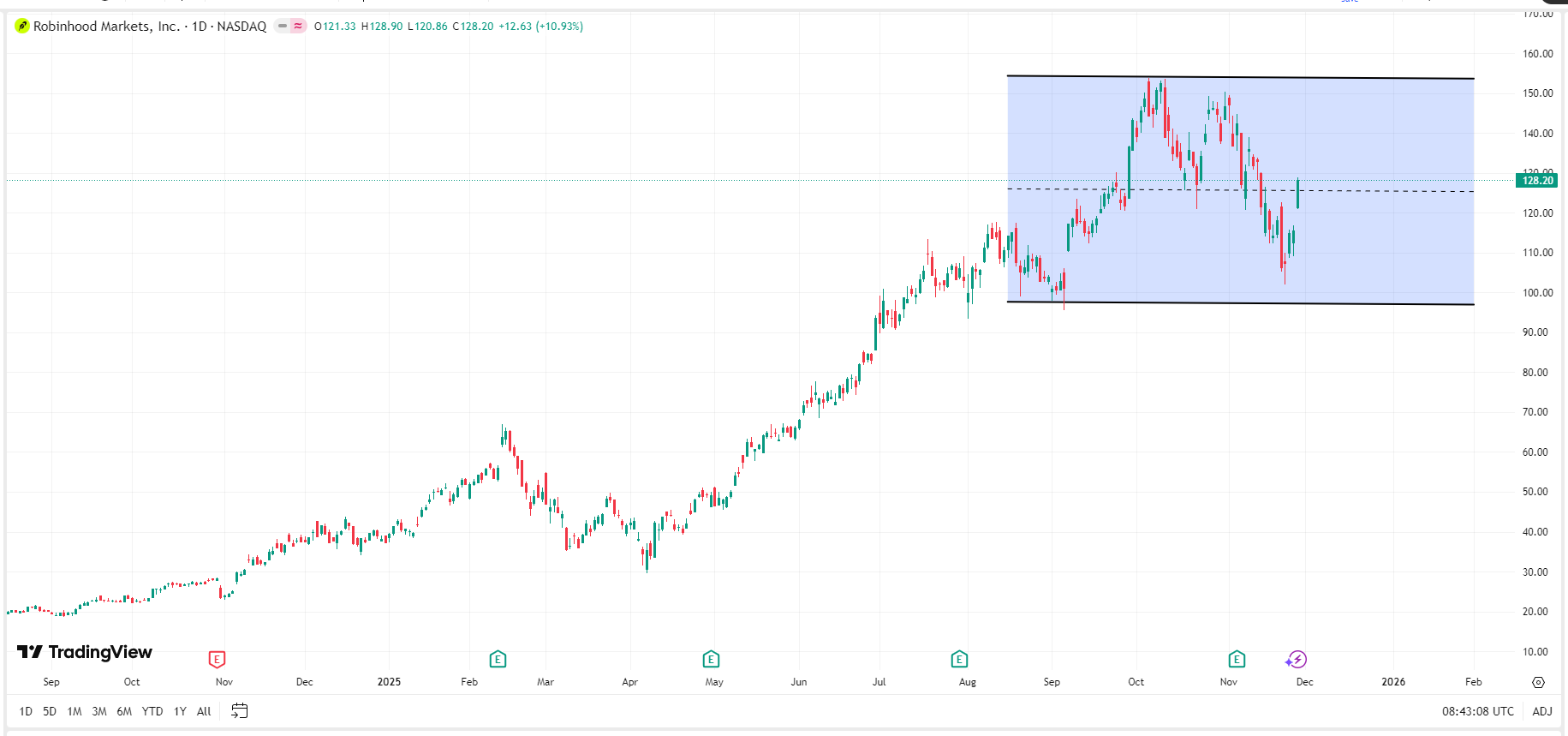Robinhood Stock Soars 300% in 2025: Is It Still a Buy?
Latest news from Robinhood
TradingKey - On November 26, fintech giant Robinhood (NASDAQ: HOOD)entered the prediction market,acquiring U.S. derivatives exchange LedgerX and futures exchange and clearinghouse MIAXdx.
On November 19, Robinhood further advanced its tokenized stock business,announcing a three-phase plan. Phase one, currently underway, allows EU users to purchase approximately 800 tokenized stocks. Phase two will enable 24/7 trading of these tokens via its acquired Bitstamp platform. The third phase will permit users to transfer or utilize tokenized stocks permissionlessly.
Earlier, on November 6, Robinhood reported stronger-than-expected third-quarter earnings.The company posted net revenue of $1.27 billion, surpassing analyst estimates of $1.21 billion. Furthermore, adjusted EBITDA reached $742 million, also exceeding analyst projections of $726.9 million.
With a series of recent positive announcements, can Robinhood's stock price climb further to new highs? Is now still a good time to buy this stock? This article will analyze whether HOOD remains a worthwhile investment from four key perspectives: fundamentals, technicals, valuation, and risks.
Is Robinhood a Chinese company?
Robinhood, a Menlo Park, California-based financial services firm, is not a Chinese company. It primarily offers equity, ETF, options, and cryptocurrency trading services.Commission-free trading is Robinhood's most notable feature, attracting a significant number of young and novice investors.
Founded in 2013 by fintech professionals Vladimir Tenev and Baiju Bhatt, Robinhood secured its initial funding round and launched its mobile application in 2014. From 2015 to 2019, Robinhood's user base soared from under 100,000 to over 6 million. In 2021, the company successfully listed on Nasdaq under the ticker "HOOD". Starting in 2023, Robinhood expanded its operations beyond the U.S.,
launching an international expansion plan to gradually enter markets such as the UK, Europe, and Singapore.
How does Robinhood make money?
Robinhood has evolved from a “zero-commission retail broker” into a diversified fintech platform, with revenue streams becoming more balanced. While trading remains its core, interest income and subscription services have grown significantly, strengthening its resilience across market cycles.
Q3 2025 Financial Highlights
According to Robinhood’s Q3 2025 earnings report, total revenue reached $1.274 billion, broken down as follows:
Revenue Category | Amount (USD) | Share | Description |
|---|---|---|---|
Trading Revenue | $730M | 57% | Driven by options, equities, and crypto . Options contributed the most ($304M), followed by crypto ($268M) and equities ($265M). |
Interest Income | $302M | 24% | Generated from cash management, margin lending, and asset interest . |
Subscription Services | $114M | 9% | From Robinhood Gold , a premium membership offering margin trading, real-time market data, and higher limits. Nearly 4M paying users boosted growth. |
Other Revenue | Small (~10%) | 10% | Includes tokenized products, advertising, and new business initiatives . |
Why is Robinhood so famous?
Fintech platform Robinhood rose to prominence for disrupting traditional brokerage models with zero-commission trading, its early embrace of cryptocurrency, and its central role in the GameStop saga.
Disruptive Innovation of Zero-Commission Trading
- Traditional US brokerages historically charged commissions of approximately $10-$25 per trade.
- Upon its launch, Robinhood introduced a "commission-free" model, a move that quickly attracted a large number of millennial investors.
Cryptocurrency and New Product Expansion
- In 2018, Robinhood officially embraced cryptocurrency, supporting the trading of digital assets like Bitcoin (BTC) and Ethereum (ETH).
- Looking ahead to 2024-2025, the platform plans to launch tokenized stocks and ETFs, incorporate S&P 500 index products, and venture into prediction markets.
IPO and Meme Stock Phenomenon
- In 2021, retail investors challenged institutions in a "David vs. Goliath" scenario, propelling the stock price of US game retailer GameStop to surge and sparking the global "meme stock" phenomenon. Robinhood drew worldwide controversy during this incident for restricting trading.
- In July of the same year, Robinhood listed on Nasdaq, raising approximately $2 billion. On its debut day, Robinhood's stock price soared, pushing its market capitalization to nearly $30 billion.
Robinhood stock historical price trend
Robinhood debuted on July 29, 2021, opening at $38 and subsequently rising. Within days, the stock surged to $85, though this momentum was short-lived. Approximately a week later, Robinhood's share price began a sustained decline. By June 16, 2022, the stock hadfallen to around $6.80, marking an all-time low.
Throughout 2023, Robinhood's shares generally traded below $10. In 2024, the stock broke out of its slump, steadily strengthening and briefly touching $40. Entering 2025, Robinhood's price further rallied, climbing from approximately $30 to a high of around $150,representing a maximum gain of over 300%.

[Robinhood Stock Price Chart, Source: TradingView]
What caused Robinhood's stock price to surge?
Robinhood's stock surged to new highs in 2025, reversing its previous decline, driven by robust earnings, product innovation, international expansion, and market sentiment.
1. Earnings Beat Expectations, Profitability Significantly Improved
- Robinhood reported strong first-quarter 2025 results. Revenue climbed 50% year-over-year to $927 million, surpassing market estimates of $921.7 million. Net income reached $336 million, a 114% year-over-year increase, with adjusted earnings per share (EPS) at $0.37. Active customers rose to 25.8 million, and Gold subscribers reached 3.2 million.
- In the second quarter of 2025, revenue hit $989 million, significantly outperforming the analyst consensus of $915 million. Net profit increased 105% year-over-year to $386 million. EPS stood at $0.42, exceeding analysts' $0.3 estimate. Funded customers grew to 26.5 million, while Robinhood Gold subscriptions reached a new record of 3.5 million.
- Third-quarter total revenue increased to $1.27 billion, well above analyst projections of $1.2 billion. EPS reached $0.61, also higher than the forecasted $0.51. Both active investing accounts and Robinhood Gold subscribers continued to set new records, reaching 27.9 million and 3.9 million, respectively.
2. Product Innovation: Tokenized Stocks and Blockchain Initiatives
- Robinhood has been tokenizing various asset classes, including commodities, U.S. stocks, and ETFs. According to data from Entropy Advisors, as of November 17, Robinhood had tokenized over 700 assets with a total value exceeding $7 million.
- Robinhood is not content with merely tokenizing shares of publicly listed companies like Nvidia, Apple, and Microsoft. The company plans to tokenize private firms such as OpenAI and SpaceX. Furthermore, it intends to partner with Arbitrum to develop its own Layer-2 blockchain, Robinhood Chain.
3. M&A Expansion and Accelerated Internationalization
- Robinhood acquired veteran European exchange Bitstamp. The company also acquired GroupLedgerX and MIAXdx from Susquehanna International, marking a significant entry into derivatives trading and prediction markets.
- The platform has expanded beyond the U.S. into the UK and European markets. It also plans to enter Asia via Singapore, underscoring its strong emphasis on internationalization strategy.
4. S&P 500 Inclusion
On September 5, S&P Dow Jones Indices announced Robinhood's inclusion in the S&P 500 after the U.S. market close. This decision attracted continuous inflows from both retail and institutional investors, further strengthening market optimism and stimulating a more than 6% surge in its stock price that day.
What are the future prospects for Robinhood?
Robinhood is transforming from a single-model trading platform into a more comprehensive, resilient financial services provider, facing significant uncertainty, opportunities, and challenges ahead.
I. Growth Engines and Opportunities
1. International Expansion – The Biggest Growth Story
- Acquisition of Bitstamp: This pivotal acquisition provides Robinhood immediate global reach, an institutional client base, and regulatory licenses, marking its most important step toward **diversifying beyond its reliance on the singular U.S. market.**
- New Market Entry: Successful penetration into the EU and UK markets, coupled with the launch of innovative products like "tokenized stock," demonstrates its capability to replicate its successful U.S. model overseas.
2. Product Diversification – Reducing Dependence on Transaction Revenue
- Retirement Accounts: Attracting users for long-term, stable investments helps stabilize its assets under custody, mitigating user attrition caused by market volatility.
- Innovative Products: New offerings such as "prediction markets" showcase its innovation capabilities and can significantly enhance user engagement and stickiness.
II. Key Risks and Challenges
1. Regulatory Uncertainty
- Its core "payment for order flow (PFOF) model" consistently faces regulatory scrutiny in the U.S. Should it be strictly restricted or banned in the future, it would fundamentally impact its business model.
- Financial regulations vary across different global markets, consequently, its international expansion pace will be heavily constrained by local regulatory bodies.
2. Reliance on Market Conditions
- Robinhood's financial performance is highly correlated with bull markets in U.S. equities and cryptocurrencies. When markets enter a prolonged bear phase and trading activity declines, its transaction-based revenue faces a significant risk of contraction. Based on Bitcoin's historical bull-bear cycles, the crypto market may be entering a bear market.
3. Intense Market Competition
- In the traditional brokerage sector, it must compete with giants like Charles Schwab and Fidelity.
- In the cryptocurrency space, it faces stiff competition from global exchanges such as Binance (BNB) and Coinbase (COIN).
Robinhood's success in this transformation hinges primarily on two areas:international expansion and product diversification (chiefly prediction markets and asset tokenization). If the transformation succeeds, Robinhood's future prospects will be relatively optimistic, potentially growing into a global financial super-app with sustained stock price appreciation potential. However, if Robinhood fails to transform, it will remain a single-model trading platform, mired in stagnant growth and highly dependent on U.S. market cyclicality.
Is it still a good time to buy Robinhood stock?
Robinhood shares are rebounding, trading around $128 and within a $100-$160 channel. Bernstein analysts target $160, seeing 25% upside from current levels.
However, can Robinhood shares continue their rally, surpassing the all-time high of $153 set on October 6? Internally, Robinhood's ongoing business transformation is in its early stages, presenting high uncertainty and limited immediate catalysts. Consequently, the stock's medium-term movement will largely depend on external factors, particularly volatility in the U.S. stock and crypto markets.

【Robinhood Stock Price Chart, Source: TradingView】
Over recent months, the three major U.S. stock indexes and Bitcoin have sustained high-level volatility. This largely stems frommarket divisions over a potential Federal Reserve rate cut in December.The prevailing market view now anticipates a December rate reduction, which could further strengthen U.S. stocks and push Robinhood shares to fresh highs.
Tracy Chen, a portfolio manager at Brandywine Global Investment Management, observed a "deep split within the Fed, but it appears the doves have overpowered the hawks." JPMorgan also reversed its outlook. Previously anticipating the Fed would maintain rates in December, the bank on November 27 made a significant pivot, now projecting a 25-basis-point rate cut for December. Moreover, CME FedWatch data shows the probability of a 25-basis-point Fed rate cut in December has climbed to 84.9%, while the chance of rates remaining unchanged stands at 15.1%.
in conclusion
Robinhood's surge this year signals a significant fintech narrative shift, as HOOD pivots towards a diverse crypto and tokenization ecosystem. The rally is more than just a return of retail investor power; it underscores a broader redefinition of its business model. No longer solely a zero-commission trading platform, Robinhood is now advancing into a multifaceted financial future built on crypto, prediction markets, and tokenization. However, the sustainability of Robinhood's stock ascent will depend short-term on continued Federal Reserve interest rate cuts, and long-term on the company's ability to successfully transform itself.



